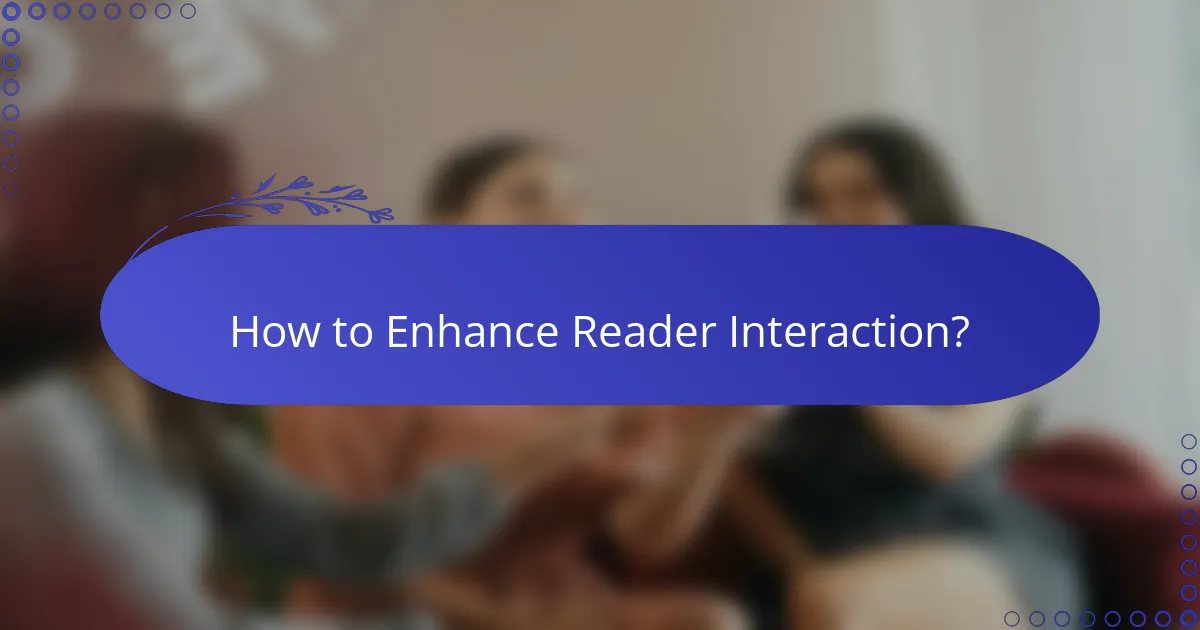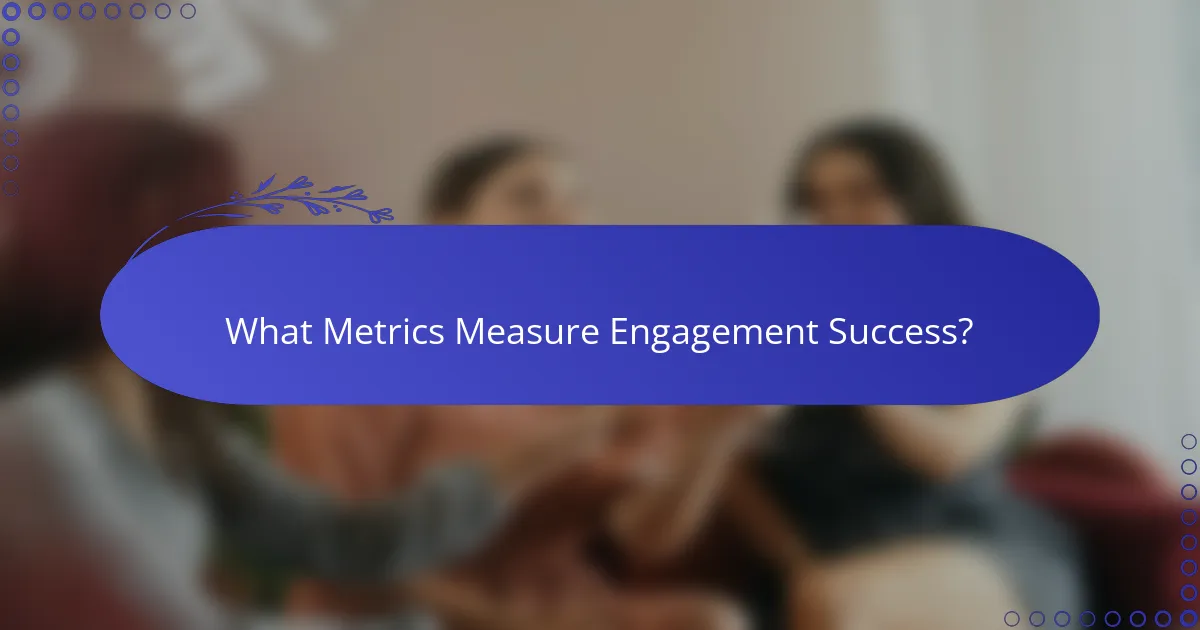Social media serves as a powerful tool for community building, allowing individuals to connect and share experiences in a dynamic environment. By implementing effective engagement strategies, brands can foster meaningful interactions and create a sense of belonging among their audience. Enhancing reader interaction not only encourages participation but also strengthens the overall community around your content.

How Can Social Media Build Community?
Social media can build community by creating spaces where individuals connect, share experiences, and engage with one another. This fosters a sense of belonging and encourages active participation among users.
Creating engaging content
Engaging content is crucial for attracting and retaining community members. This includes eye-catching visuals, relatable stories, and interactive posts that invite responses. Aim for a mix of formats such as videos, polls, and infographics to keep the audience interested.
Consider using trending topics or themes relevant to your audience to enhance engagement. Regularly updating content and maintaining a consistent posting schedule can significantly boost interaction rates.
Fostering user-generated content
User-generated content (UGC) encourages community members to contribute their own material, enhancing engagement and ownership. This can include photos, testimonials, or creative responses to prompts you provide. Highlighting UGC not only builds trust but also strengthens community ties.
To encourage UGC, create specific campaigns or challenges that invite participation. Recognizing and rewarding contributors can further motivate others to share their experiences.
Utilizing community groups
Community groups on platforms like Facebook or LinkedIn serve as dedicated spaces for members to connect over shared interests. These groups can facilitate deeper discussions and provide a sense of exclusivity. Ensure that the group is well-moderated to maintain a positive environment.
Regularly engage with group members through prompts, Q&A sessions, or themed discussions to keep the conversation flowing. This approach helps in building a loyal and active community.
Hosting live events
Live events, such as webinars, Q&A sessions, or virtual meet-ups, can significantly enhance community interaction. These events allow real-time engagement, fostering a sense of immediacy and connection among participants. Promote these events in advance to maximize attendance.
Consider using platforms like Zoom or Instagram Live, which are user-friendly and widely accessible. Follow up with participants after the event to maintain the momentum and encourage ongoing discussions.
Encouraging discussions
Encouraging discussions within your community is essential for building engagement. Pose open-ended questions, create discussion threads, and respond actively to comments to stimulate conversation. This not only keeps the community vibrant but also makes members feel valued.
Be mindful of moderating discussions to ensure they remain respectful and constructive. Establishing community guidelines can help set expectations and foster a positive atmosphere for dialogue.

What Are Effective Engagement Strategies?
Effective engagement strategies are methods that foster interaction and connection between a brand and its audience on social media. These strategies enhance community building by encouraging participation, feedback, and a sense of belonging among followers.
Personalized interactions
Personalized interactions involve tailoring responses and content to individual users based on their preferences and behaviors. This can include addressing followers by name, referencing their past interactions, or creating content that resonates with their interests. Such approaches can significantly increase user loyalty and engagement.
To implement personalized interactions, consider using data analytics tools to track user behavior and preferences. This allows you to segment your audience and deliver targeted messages that feel relevant and meaningful.
Utilizing polls and surveys
Polls and surveys are effective tools for engaging your audience and gathering valuable feedback. They encourage participation by allowing users to express their opinions on various topics, which can also inform your content strategy. Simple polls can be conducted through social media stories or posts, while more detailed surveys can be shared via links.
When creating polls or surveys, keep questions clear and concise. Aim for a mix of multiple-choice questions and open-ended responses to gather both quantitative and qualitative data. Offering small incentives, like discounts or giveaways, can also boost participation rates.
Responding to comments promptly
Timely responses to comments demonstrate that you value your audience’s input and foster a sense of community. Engaging with users quickly can lead to higher satisfaction and encourage more interactions in the future. Aim to respond to comments within a few hours, if possible.
To streamline this process, set aside dedicated time each day to monitor and respond to comments. Consider using social media management tools that alert you to new interactions, making it easier to stay on top of engagement.
Incorporating multimedia content
Multimedia content, such as images, videos, and infographics, can significantly enhance engagement on social media platforms. Visual content tends to capture attention more effectively than text alone and can convey messages quickly and clearly. Incorporating a variety of formats keeps your feed dynamic and interesting.
When creating multimedia content, ensure it aligns with your brand identity and resonates with your target audience. Utilize tools like Canva or Adobe Spark for creating eye-catching graphics, and consider using short videos or live streams to engage followers in real-time.

How to Enhance Reader Interaction?
Enhancing reader interaction involves actively engaging your audience through various strategies that encourage participation and feedback. By implementing effective methods, you can foster a sense of community and improve overall engagement with your content.
Encouraging feedback
Encouraging feedback is essential for understanding your audience’s needs and preferences. Create opportunities for readers to share their thoughts through comments, surveys, or polls. Consider using platforms like Google Forms or Typeform to gather structured feedback easily.
Make it clear that you value their opinions by responding to comments and incorporating their suggestions into future content. This not only boosts engagement but also builds trust within your community.
Creating interactive stories
Interactive stories captivate readers by allowing them to influence the narrative. Use tools like Twine or StoryMapJS to create branching storylines where readers can make choices that affect the outcome. This approach keeps readers invested and encourages them to return for more.
Consider incorporating multimedia elements such as images, videos, or audio clips to enhance the storytelling experience. This not only makes the content more engaging but also caters to different learning styles.
Implementing Q&A sessions
Q&A sessions provide a direct line of communication between you and your audience. Schedule regular live sessions on platforms like Instagram Live, Facebook Live, or YouTube to answer questions in real-time. Promote these events in advance to maximize participation.
Encourage readers to submit questions beforehand to ensure a more organized session. This strategy not only boosts engagement but also demonstrates your commitment to addressing reader concerns.
Utilizing chatbots for engagement
Chatbots can enhance reader interaction by providing instant responses to common queries. Implement chatbots on your website or social media channels to assist with FAQs, guide users through content, or even collect feedback. Tools like ManyChat or Chatfuel can help you set up these bots easily.
Ensure your chatbot is user-friendly and capable of escalating complex inquiries to a human representative. This balance helps maintain engagement while providing a seamless experience for your audience.

What Tools Support Community Building?
Effective community building relies on various tools that facilitate interaction and engagement among members. These platforms cater to different needs, from casual discussions to professional networking, enhancing the overall community experience.
Facebook Groups
Facebook Groups are popular for fostering community engagement around shared interests or goals. They allow members to post updates, share resources, and interact through comments and reactions.
When creating a group, consider setting clear guidelines to maintain a positive environment. Regularly engage with members by posting questions or polls to encourage participation.
Discord for real-time communication
Discord is designed for real-time communication, making it ideal for communities that thrive on instant interaction. It offers voice, video, and text channels, allowing for diverse communication styles.
To maximize engagement, create themed channels for specific topics and host regular events like Q&A sessions or game nights. This keeps the community active and connected.
Slack for professional communities
Slack is tailored for professional environments, facilitating collaboration and networking among members. It supports channels for different projects or topics, direct messaging, and file sharing.
Establish clear channels based on interests or professional fields to streamline discussions. Encourage members to share insights and resources to foster a supportive atmosphere.
Reddit for niche discussions
Reddit hosts a variety of niche communities, known as subreddits, where users can engage in focused discussions. Each subreddit has its own rules and culture, catering to specific interests.
To build a successful subreddit, actively moderate discussions and encourage user-generated content. Use flair to categorize posts and maintain organization, enhancing user experience.

What Metrics Measure Engagement Success?
Engagement success on social media is primarily measured through metrics that indicate how users interact with content. Key metrics include engagement rate, reach, and impressions, which together provide insights into audience behavior and content effectiveness.
Engagement rate
The engagement rate quantifies how actively users interact with your content, typically expressed as a percentage. It is calculated by dividing the total engagements (likes, comments, shares) by the total reach or impressions and multiplying by 100.
For example, if a post receives 100 likes and has a reach of 1,000 users, the engagement rate would be 10%. A higher engagement rate often indicates that the content resonates well with the audience, making it a crucial metric for assessing social media performance.
To improve your engagement rate, focus on creating compelling content that encourages interaction, such as asking questions or using polls. Avoid posting too frequently without engaging with your audience, as this can lead to lower interaction rates.
Reach and impressions
Reach refers to the total number of unique users who see your content, while impressions count how many times your content is displayed, regardless of whether it was clicked or not. Understanding both metrics helps gauge the visibility of your posts.
For instance, if a post has a reach of 500 but 1,000 impressions, it means that some users saw the post multiple times. Monitoring these metrics can help identify which content types are most effective at capturing attention.
To maximize reach and impressions, consider using targeted advertising or engaging with trending topics. Avoid overly promotional content, as this can lead to audience fatigue and decreased visibility over time.
